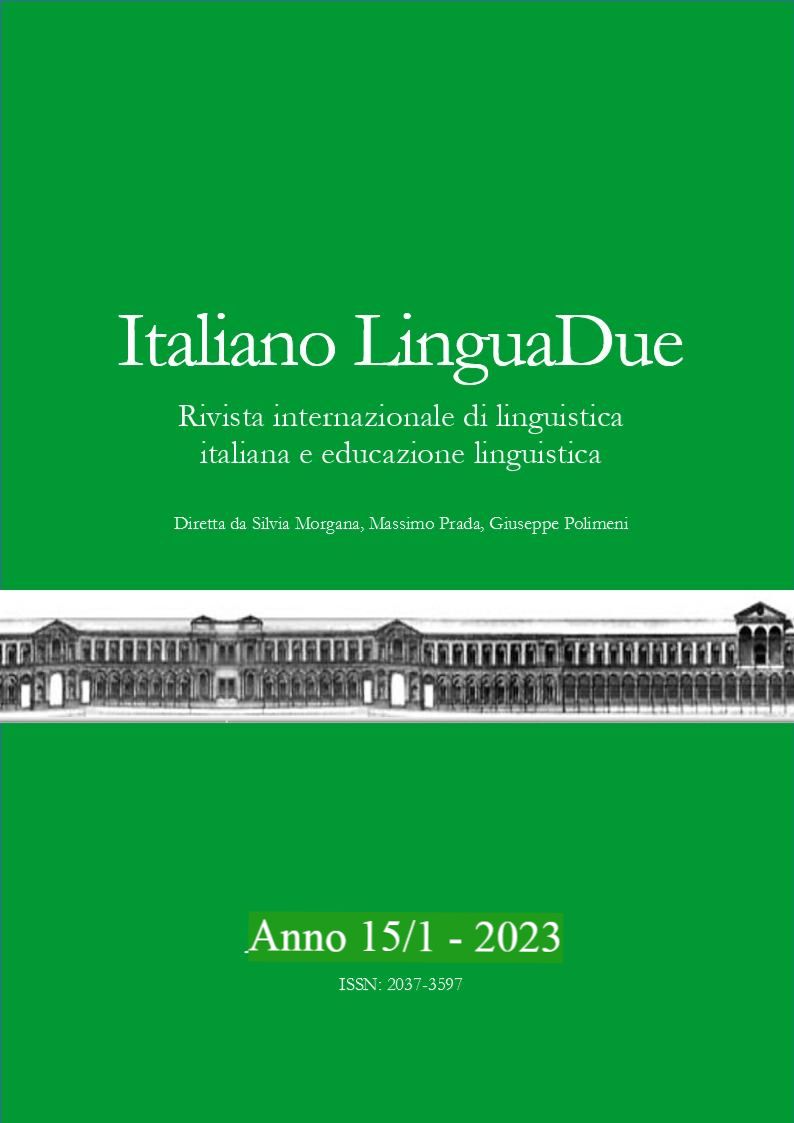APPRENDIMENTO DELLA L2 E PROCESSI DI RI-COSTRUZIONE DELL’IDENTITÀ: ANALISI DELL’AUTOBIOGRAFIA SOCIOLINGUISTICA DI EVA HOFFMAN
DOI:
https://doi.org/10.54103/2037-3597/20426Abstract
Questo articolo analizza il romanzo di Eva Hoffman Lost in translation, tradotto in italiano nel 1996 da Donzelli con il titolo Come si dice e ripubblicato nel 2021 da Erickson con il titolo La lingua del tempo. Dopo aver esplorato i poli lingua e identità culturale, intese l’una come strumento e l’altra come relazione, lo scritto indaga la traiettoria di apprendimento della L2 (l’inglese americano) da parte dell’autrice, investigando il ruolo di questo apprendimento linguistico nella ri-costruzione della sua identità nella migrazione. I risultati dell’analisi possono essere utili in particolar modo per chi opera in contesti plurilingui, sia per decentrare il proprio punto di vista rispetto agli stereotipi e ai pregiudizi talvolta associati all'apprendimento di una L2 in contesto migratorio, sia per comprendere la complessità delle variabili che determinano la ri-costruzione dell’identità linguistica di tutti gli apprendenti.
L2 learning and identity re-construction processes: analysis of eva hoffman’s sociolinguistic autobiography
The present paper analyzes the novel by Eva Hoffman Lost in translation, translated into Italian in 1996 by Donzelli with the title Come si dice and republished in 2021 by Erickson with the title La lingua del tempo. After exploring the poles of language and cultural identity, understood one as a tool and the other one as a relationship, the paper investigates the trajectory of second language learning (American English) by the author, examining the role of the language learning in the re-construction of her identity in migration. The results of the analysis can be useful in particular for those who work in multilingual contexts, both to decentralize their point of view with respect to the stereotypes and prejudices sometimes associated with second language learning in a migratory context, and to understand the complexity of the variables that determine the re-construction of the linguistic identity of all learners.
Riferimenti bibliografici
Benson P., Barkhuizen G., Bodycott P., Brown J. (2013), Second language identity in narratives of study abroad, Palgrave Macmillan, Basingstoke.
Bonifacci P. (a cura di) (2018), I bambini bilingui. Favorire gli apprendimenti nelle classi multiculturali, Carocci, Roma.
Bruner J. S. (1992), La ricerca del significato. Per una psicologia culturale, Bollati Boringhieri, Torino.
Bruner J. S. (1991), “La costruzione narrativa della realtà”, in Ammaniti M., Stern D.N. (a cura di), Rappresentazioni e narrazioni, Laterza, Bari-Roma.
Burr V. (1996), An introduction to social constructionism, Routledge, London.
Cardona M., Luise M. C. (2019), Learning in the Old Age. Motivation, Emotions Experiences, Soleil publishing-Beccarelli, Toronto-Siena.
Celentin P. (2019), Le variabili dell’apprendimento linguistico. Perché non tutti impariamo le lingue nello stesso modo, QuiEdit, Verona.
Daloiso M. (cds), “L’ideologia del madrelinguismo nell’accostamento alla lingua inglese in contesto prescolare”, in Italian Studies in Southern Africa/Studi di italianistica nell’Africa Australe.
Ehrman M. E. (1999), “Ego Boundaries and Tolerance of Ambiguity in Second Language Learning”, in Arnold J. (ed.), Affect in Language Learning, Cambridge University Press, Cambridge.
Guiora A. Z., Brannon R. C., Dull C.Y. (1972), “Empathy and Second Language Learning”, in Language Learning, XXII, pp. 111-130.
Hampson C. (1996), “The social psychology of personality”, in Cooper C., Varma V. (eds.), Processes in Individual Differences, Routledge, London.
Hartmann E. (1991), Boundaries in the mind: A new psychology of personality, Basic Books, New York.
Holliday A. (1999), “Small Cultures”, in Applied Linguistics, XX, 2, pp. 237-264.
Holliday A. (20182), Understanding intercultural communication: negotiating a grammar of culture, Routledge, New York.
Holliday A., Hyde M., Kullman J. (2010), Intercultural communication: an advanced resource book for students, Routledge Applied Linguistics, New York.
Kramsch C. (2004), “The Multilingual Experience: Insights from Language Memoirs”, in TRANSIT, I. 1, Berkeley: https://escholarship.org/uc/item/9h79g172.
Lave J., Wenger E. (2006), L’apprendimento situato. Dall’osservazione alla partecipazione attiva nei contesti di apprendimento, Erickson, Trento.
Norton B. (2017), “Learner investment and language teacher identity”, in Barkhuizen G. (ed.), Refections on language teacher identity research, Routledge-Taylor & Francis, New York, pp. 80-86.
Pavlenko A. (2007), “Autobiographic Narratives as Data in Applied Linguistics”, in Applied Linguistics, XXVIII, 2, pp. 163-188.
Pavlenko A., Lantolf J.P. (2000), “Second language learning as participation and the (re)construction of selves”, in Lantolf J. P. (ed.), Sociocultural Theory and Second Language Learning, Oxford University Press, Oxford, pp. 162-173.
Pellegrino Aveni V. (2005), Study Abroad and Second Language Use, Cambridge University Press, Cambridge, pp. 9-16.
Salvadori E. (2016), “Narrare le nostre lingue”, in Anfosso G., Polimeni G., Salvadori E. (a cura di), Parola di sé. Le autobiografie linguistiche tra teoria e didattica, FrancoAngeli, Milano. Schmid M. S. (2013), “First language attrition”, in Linguistic Approaches to Bilingualism, III, 1, pp. 96-117.
Schmid M. S. (2013), “First language attrition”, in Linguistic Approaches to Bilingualism, III, 1, pp. 96-117.
Schumann J. H. (1976), “Second Language Acquisition: The Pidginization Hypothesis”, in Language Learning, XXVI, 2, pp. 391-408.
Schumann F., Schumann J. (1977), “Diary of a language learner: An introspective study of second language learning”, in Brown H. D., Crymes R., Yorio C. (eds.), Teaching and Learning: Trends in Research and Practice, TESOL, Washington, DC.
Sfard A. (1998), “On Two Metaphors for Learning and The Dangers of Choosing Just One”, in Educational Research, XXVII, 2, pp. 4-13.
van Lier L. (2000), “From input to affordance: Social-interactive learning from an ecological perspective”, in Lantolf J. P. (ed.) Sociocultural Theory and Second Language Learning, Oxford University Press, Oxford, pp. 245-260.
Dowloads
Pubblicato
Fascicolo
Sezione
Licenza
Copyright (c) 2023 Italiano LinguaDue

Questo lavoro è fornito con la licenza Creative Commons Attribuzione - Condividi allo stesso modo 4.0.




